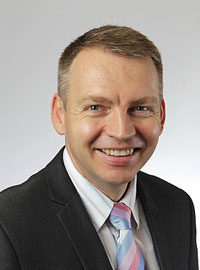| Aug 18, 2013 | |
Pharmacy academic takes nanomedicine research global |
|
| (Nanowerk News) University of Sydney Faculty of Pharmacy researcher, Dr Wojciech Chrzanowski, has gained international attention for his groundbreaking work on biomaterial technologies, an area that seeks to enhance the integration between human cells and surgical implants. | |
 Dr Wojciech Chrzanowski: "There is an urgent need for a technology that is capable of improving implant integration." Dr Chrzanowski's research into this microscopic biochemical 'braille' concept has just netted him first prize in the poster presentation category at the inaugural International Translational Nanomedicine Conference at Northeastern University in Boston, USA. More recently, Dr Chrzanowski was named a recipient of the Japan Society for the Promotion of Science (JSPS) Invitational Fellowships for Foreign Researchers 2013 - an extremely competitive and prestigious appointment promoting international scientific cooperation. He will travel to Japan in November to collaborate with world-leading biomaterial scientists Professor Tadashi Kokubo (Chubu University) and Professor BJ Kim (Tokyo University). The project will focus on understanding and improving the way cells interact with the biomaterials of implant surfaces, and enable the development of novel biomaterials, nanotherapeutics and technologies for studying these interactions. |
|
| The research will seek to develop its own 'Braille' system to make implants surfaces more 'readable' for cells and therefore improve their integration and function in the body. | |
| "I am honoured and very excited to receive this level of recognition, with the award from the Translational Nanomedicine conference and also the prestigious fellowship," Dr Chrzanowski said. | |
| "I'm looking forward to continuing my research in collaboration with one of the most recognised biomaterials scientists and engage in new research at Tokyo University." | |
| Behind Dr Chrzanowski's award-winning research is the simple, but brilliant concept of braille - the physical language of bumps developed to help visually-impaired people 'read'. | |
| Dr Chrzanowski's prestigious JPRS Fellowship will allow him and collaborative researchers to better understand how this braille-like concept could be exploited on the smallest possible level, for the smallest possible audiences - cells. | |
| Applying this idea to optimise surgical implants could prove to be incredibly beneficial to patients' lives and the national health system. | |
| "There is an urgent need for a technology that is capable of improving implant integration, particularly countries with rapidly aging populations, such as Australia," said Dr Chrzanowski. | |
| For example, a large number of trauma incidents results in millions of fractures needing treatment. There are over six million fractures a year in the US alone, which is roughly nine fractures every minute that require an implantable fixation device. | |
| "The implantation of metal devices into tissues is carries a high risk of post-operative complications, which are caused by poor integration of the implant and biofilm formation," Dr Chrzanowski said. | |
| "These are regarded as the most dreaded complications in orthopedics that result in repeat surgeries, patient distress and disability, and increased cost and utilisation of medical resources - recent data shows the number of revision operations in Australia is steadily increasing at a rate of around 6 percent per annum," he said. | |
| Dr Chrzanowski begins his Fellowship in November. |
| Source: University of Sydney |
